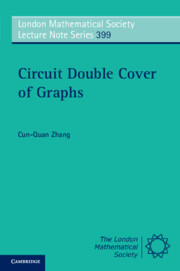Book contents
- Frontmatter
- Contents
- Foreword
- Foreword
- Preface
- 1 Circuit double cover
- 2 Faithful circuit cover
- 3 Circuit chain and Petersen minor
- 4 Small oddness
- 5 Spanning minor, Kotzig frames
- 6 Strong circuit double cover
- 7 Spanning trees, supereulerian graphs
- 8 Flows and circuit covers
- 9 Girth, embedding, small cover
- 10 Compatible circuit decompositions
- 11 Other circuit decompositions
- 12 Reductions of weights, coverages
- 13 Orientable cover
- 14 Shortest cycle covers
- 15 Beyond integer (1, 2)-weight
- 16 Petersen chain and Hamilton weights
- Appendix A Preliminary
- Appendix B Snarks, Petersen graph
- Appendix C Integer flow theory
- Appendix D Hints for exercises
- Glossary of terms and symbols
- References
- Author index
- Subject index
11 - Other circuit decompositions
Published online by Cambridge University Press: 05 May 2012
- Frontmatter
- Contents
- Foreword
- Foreword
- Preface
- 1 Circuit double cover
- 2 Faithful circuit cover
- 3 Circuit chain and Petersen minor
- 4 Small oddness
- 5 Spanning minor, Kotzig frames
- 6 Strong circuit double cover
- 7 Spanning trees, supereulerian graphs
- 8 Flows and circuit covers
- 9 Girth, embedding, small cover
- 10 Compatible circuit decompositions
- 11 Other circuit decompositions
- 12 Reductions of weights, coverages
- 13 Orientable cover
- 14 Shortest cycle covers
- 15 Beyond integer (1, 2)-weight
- 16 Petersen chain and Hamilton weights
- Appendix A Preliminary
- Appendix B Snarks, Petersen graph
- Appendix C Integer flow theory
- Appendix D Hints for exercises
- Glossary of terms and symbols
- References
- Author index
- Subject index
Summary
Restricted circuit decompositions
By looking at the incorrect proof presented in Section 10.1, one may suggest some different restrictions so that some circuit decompositions of eulerian graphs may imply the CDC conjecture.
Example 1 Let H be the even graph obtained from a bridgeless cubic graph G by adding a path of length 2 between every pair {x, y} if xy ∈ E(G). If H has a circuit decomposition ℱ such that every member of ℱ is of even length, then ℱ corresponds to a circuit double cover of the original graph G.
Example 2 Let H be the even graph described in the previous example. If H has a circuit decomposition ℱ′ such that no member of ℱ is of length 3, then ℱ′ corresponds to a circuit double cover of the original graph G.
Those two examples motivated some related studies of special circuit decompositions of eulerian graphs.
Theorem 11.1.1 (Seymour [206]) If H is a planar even graph such that every block contains an even number of edges, then H has a circuit decomposition consisting of even circuits.
Theorem 11.1.2 (Zhang [255]) If H is a K5-minor-free even graph such that every block contains an even number of edges, then H has a circuit decomposition consisting of even circuits.
Theorem 11.1.2 is an application of Theorem 10.3.3. A proof of this theorem different from the original paper [255] can be found in [259] which uses a removable circuit theorem in [87] and, therefore, it is an application of both Theorems 10.3.3 and 12.1.2.
- Type
- Chapter
- Information
- Circuit Double Cover of Graphs , pp. 134 - 136Publisher: Cambridge University PressPrint publication year: 2012



